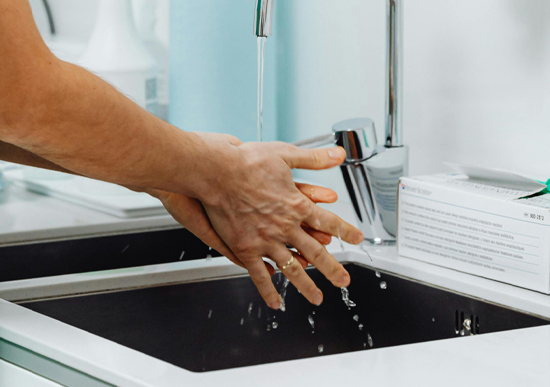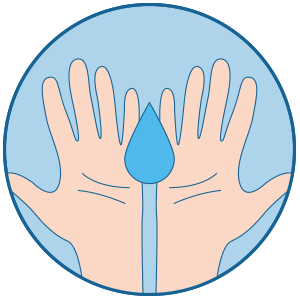What is the Best Way to Control Contamination on the Hands?
 Handwashing has been an essential part of good hygiene practices for manufacturing drug products for over a century.
Handwashing has been an essential part of good hygiene practices for manufacturing drug products for over a century.
At present, there are many methods that are used by sterile drug manufacturing employees to clean and sanitize their hands before gowning and while wearing sterile gloves. Handwashing has evolved from simply washing hands with hot water to complex processes such as washing hands and forearms up to elbows for at least 30 seconds, cleaning under fingernails and drying with low-lint disposable towels or wipes. The use of 70% isopropyl alcohol (IPA) has also become a practice that is used in lieu of handwashing, which ranges from simple spritzes of alcohol on the hands to total soaking of hands with IPA, wiping off the hands with a sterile wipe and applying IPA a second time then allowing hands to air dry.
Over the last 30 years, aseptic personnel have gradually become a standard practice to apply IPA frequently to their outer (second pair) sterile gloves as they perform their aseptic work. During the COVID-19 pandemic, there were significant arguments over whether it was better to use soap and water or IPA to wash and sanitize hands to prevent virus transmission. The evidence relied on during the arguments supported one or the other position, with no one practice providing 100% reliability. The same situation is found in aseptic manufacturing. This article will review the evidence and provide recommendations on the best processes to use for cleaning and sanitizing hands before gowning and the need for frequent application of sterile IPA to sterile gloves.
A Review of the Available Literature
After researching the literature (115 studies and references), it became evident that many of the studies performed on handwashing and alcohol use to sanitize hands were not standardized and could not be used to determine the true effectiveness of either method. Many of the studies were performed in healthcare settings and studies in pharmaceutical aseptic cleanrooms were rare. Only four published studies examined handwashing within an aseptic cleanroom operation, and two of those studies were in a compounding operation.
In 2010, Keen et al. did a controlled study to determine if glove and surgical instrument disinfection after mouse surgeries using a thirty-second contact time with 70% IPA would allow the same gloves and instruments to be used repeatedly without sterilization. The study found that the IPA sanitization of the gloves and instruments prevented bacterial contamination of the gloves for up to five mouse surgeries, and only two samples from surgical instruments were contaminated using the same instruments during the study. The gloves post-surgical sampling before disinfection found elevated levels of microbial contaminants on the gloves prior to sanitization with the IPA.
Across all control and experimental groups, no bacterial growth was found on autoclaved instruments and sterile surgical gloves prior to each procedure.
 Clinical adverse events caused by viral contamination of hospital equipment led Ribeiro et, al. to study surface disinfection of equipment surfaces with 70% IPA. Although this study did not look specifically at hand or glove sanitization, it did provide information that could be considered important when preparing procedures for hand and glove sanitization. This study found that after materials were disinfected with IPA rubbed on surfaces for 10 seconds, microorganisms were detected in 104/282 (36.9%) effectiveness tests and in 23/92 (25.0%) efficacy tests that were conducted. Field studies found that disinfection was not achieved for 74/218 (33.9%) of the products that were submitted to previous cleaning. In controlled laboratory studies, IPA disinfection was not efficacious in 11/30(36.7%) and non-sterile 12/62 (19.4%) products, respectively.
Clinical adverse events caused by viral contamination of hospital equipment led Ribeiro et, al. to study surface disinfection of equipment surfaces with 70% IPA. Although this study did not look specifically at hand or glove sanitization, it did provide information that could be considered important when preparing procedures for hand and glove sanitization. This study found that after materials were disinfected with IPA rubbed on surfaces for 10 seconds, microorganisms were detected in 104/282 (36.9%) effectiveness tests and in 23/92 (25.0%) efficacy tests that were conducted. Field studies found that disinfection was not achieved for 74/218 (33.9%) of the products that were submitted to previous cleaning. In controlled laboratory studies, IPA disinfection was not efficacious in 11/30(36.7%) and non-sterile 12/62 (19.4%) products, respectively.
The experiment found that the IPA 10-second rubbing was effective at eliminating herpes simplex virus, but type 5 adenovirus was found on the samples. Adenoviruses are a group of DNA viruses that easily infect humans and are responsible for the common cold and other viral infections. A type 8 adenovirus caused an epidemic keratoconjunctivitis outbreak in patients exposed to a pneumotonometer despite the fact it was cleaned with 70% isopropyl alcohol.
This study concluded that procedures using a 10-second rub with IPA are not safe for disinfection of microbial contamination found on semi-critical instruments. Different disinfection methods should be based on the microorganism bioburden, organic and inorganic residues, and the type of instruments being disinfected. This is cautionary evidence that a 10-second rub with IPA on gloves may not effectively disinfect the gloves used in cleanrooms, depending upon the dirt load.
A 2023 study on the efficacy of various handwashing methods against enveloped and non-enveloped viruses by Anderson et al. relied upon very controlled test procedures using RT-qPCR and is one of the best studies found on handwashing. The study found that several alternative handwashing methods, but not all, were as effective in a laboratory setting for the removal and inactivation of viral surrogates as washing with soap and water for 20 seconds. Washing with soapy water and water alone for 20 seconds had testing data similar to washing with soap and water for 20 seconds. Additionally, the study found that IPA disinfection of hands was effective for enveloped viruses but not for non-enveloped viruses, which was expected based on previous laboratory studies. The test results found that handwashing using towel methods did not remove the viral surrogates used.
An interesting study conducted using nurses in a hospital setting conducted by Aman Nation et al. found there was no significant difference between using a 0.175% chloroxylenol/0.3% salicylic acid soap handwashing method compared to a 70% ethyl alcohol rub in reducing the bioburden on hands. The average of total colonies decreased by 59.5% using the handwashing method and by 47.2% using the 70% ethyl alcohol rub.
Baseline testing of the nurses found Staphylococcus epidermidis in 10 samples (47.62%), coagulase-negative staphylococci (CoNS) in 6 samples (28.75%), Bacillus subtilis in 2 samples (9.52%), Klebsiella oxytoca in 2 samples (9.52%) and 1 sample containing Escherichia coli (4.76%). After using the 70% ethyl alcohol hand rub, test samples did not find Klebsiella oxytoca and E. coli. Still, they did find Staphylococcus epidermidis on ten samples (55.55%), CoNS in six samples (33.33%) and Bacillus subtilis in two samples (11.12%). The findings support the requirement that sterile gloves be worn during aseptic operations even though bioburden is reduced by hand washing or alcohol rubs because the hands are not sterile after washing.
The U.S. Food and Drug Association’s (FDA) Produce Safety Rule provides general guidelines like those found in a pharmaceutical hygiene program. A study conducted using farmworkers demonstrated the need for an effective handwashing procedure to reduce microbial contamination. Although the study conducted by Prince-Guerra et al. examined highly soiled hands, the procedures evaluated provide a good basis for application within the pharmaceutical industry.
The concentrations of soil and some bacterial indicators on hands significantly differed across produce commodities that the farm workers were harvesting. Without hand hygiene, bacterial concentrations of 0.88 – 5.1 log10 CFU/hand) were observed and there was a moderate correlation (ρ = −0.41 – 0.56) between soil load and bacterial concentrations. Data in the study found that a two-step IPA intervention was comparable to handwashing with soap and water in reducing bacteria on farmworker hands, but handwashing does not always reduce bioburden on the hands.
 The farm workers performed handwashing by rinsing hands under potable water, rubbing 2 ml of non-antimicrobial hand soap onto the hands for ∼15 – 20 seconds, rinsing again with potable water and then drying the hands with a single-use paper towel.
The farm workers performed handwashing by rinsing hands under potable water, rubbing 2 ml of non-antimicrobial hand soap onto the hands for ∼15 – 20 seconds, rinsing again with potable water and then drying the hands with a single-use paper towel.
The two-step IPA rub process starts by applying 3 – 4.5 ml (two to three dispenser pumps) of IPA to the hands. After rubbing the hands for ∼15 – 20 seconds, excess IPA is wiped off with a single-use paper towel. Lastly, an additional pump of IPA is dispensed, and the worker’s hands are rubbed together until dry.
The results were that handwashing exhibited ∼1.4 log10 reduction and the two-step IPA procedure exhibited ∼ 0.4 log10 reduction in hand microbial bioburden compared with the control groups.
The U.S. Food and Drug Administration's (FDA) Food Safety Modernization Act, Final Rule on Produce Safety requires that personnel wash their hands with soap and water but the FDA’s Produce Safety Rule clearly states that “you may not use antiseptic hand rubs as a substitute for soap (or other effective surfactant) and water” because they are ineffective at removing bacteria when dirt, grease and oil are present on people's hands. Prince-Guerra et al. hypothesized that the amount and types of soil and microbes present on farmworker hands prior to handwashing might influence the efficacy of different hand hygiene methods at reducing microbial contamination, and he recommend that the FDA Final Rule on Produce Safety should allow the use of a two-step IPA hand sanitization procedure in places where handwashing with soap and water is not available.
The Prince-Guerra article demonstrates the need for science-based flexibility when designing hygiene programs for pharmaceutical use.
It is known that people do not consistently wash their hands. An observational video and soil removal study by Chen Shi et al. highlighted the variability found when a total of 744 videos of 664 subjects were reviewed and graded on the observed practices. Individual hand-washing effectiveness was quantified by the percentage of residual fluorescent gel on each subject's hands' back and palm areas.
Rubbing between fingers was the most frequently omitted step, and rubbing the back of fingers was the most frequently performed incorrectly. After considering all variables associated with washing hands, rubbing hands during rinsing and rinsing time were significantly associated with hand washing effectiveness. The optimal overall hand washing time was 31 seconds, with each step ideally lasting 4 – 5 seconds, except for rubbing between fingers. The palms of both hands had fewer fluorescent residuals than the back of the hands. The areas where residuals appeared were wrists, followed by fingertips, finger webs and thumbs.
This study reinforced the need for effective personnel training to perform hand washing in a consistent step-by-step process that emphasizes no shortcuts are allowed. Trainers can use fluorescent gel applied to the hands before washing as a valuable tool when training pharmaceutical personnel.
A meta-analysis conducted by Ian Ross, PhD, on the effectiveness of handwashing with soap to prevent acute respiratory infections supports previously discussed study results that show reduced incidence of infection after interventional handwashing is instituted in health care settings of low- and middle-income countries (1).
 One contrarian study, A Comparison of the Bacterial Contamination of the Surface of Cleanroom Operators’ Garments Following Donning with and Without Gloves, by Laurie M. Smith et, al. found significant contamination of cleanroom garments after donning. This study only had 27 operator gowning events that were sampled with and without wearing gloves. It was astonishing to find that contamination was observed in the middle of the back of the garments after donning. However, there was little information on the training used for the operators, their qualification results or observed gowning practices. Additionally, the use of IPA was not discussed to decontaminate the packages holding the garments, the bench in the cleanroom or the gloves after each step of the donning process. This article further proposes that there was no difference in the levels of bacterial contamination on operator garments between bare hands, non-sterile gloves or sterile cleanroom gloves. Given the deficiencies noted above, this study should be repeated using larger populations and following current pharmaceutical aseptic gowning practices.
One contrarian study, A Comparison of the Bacterial Contamination of the Surface of Cleanroom Operators’ Garments Following Donning with and Without Gloves, by Laurie M. Smith et, al. found significant contamination of cleanroom garments after donning. This study only had 27 operator gowning events that were sampled with and without wearing gloves. It was astonishing to find that contamination was observed in the middle of the back of the garments after donning. However, there was little information on the training used for the operators, their qualification results or observed gowning practices. Additionally, the use of IPA was not discussed to decontaminate the packages holding the garments, the bench in the cleanroom or the gloves after each step of the donning process. This article further proposes that there was no difference in the levels of bacterial contamination on operator garments between bare hands, non-sterile gloves or sterile cleanroom gloves. Given the deficiencies noted above, this study should be repeated using larger populations and following current pharmaceutical aseptic gowning practices.
When it comes to wearing sterile gloves, there are a few myths that have been studied by the surgery centers. Denise Korniewicz and Maher El-Masri explored the benefits of double gloving during surgery and the human factors associated with cleanroom glove use. They conducted a 24-month study and found that sterile gloves develop micro-perforations over time as they are worn. The process of wearing two gloves needs to be carefully designed with attention paid to the type and make of sterile gloves purchased to maintain dexterity and ease of donning. The study also found that wearing different colored gloves in a double-gloving practice allows for earlier detection of perforations and timely glove replacement, thereby reducing the risk of contamination.
Tim Sandle, PhD, proposed a schema for glove disinfection in 2023 that set an effective baseline for the use of gloves in aseptic operations (2). In his article, the importance of each element of glove selection, donning process design, glove disinfection, handling of cleanroom items and assessment of practices was discussed along with data related to sterile glove handling. As stated earlier, this article also mainly references studies conducted in healthcare settings with only a few that address pharmaceutical aseptic practices.
Based upon over 40 years of pharmaceutical aseptic clean room operations management, I have observed years of employee gowning test data and have found that there are exceptionally low rates of glove and gown contamination when effective employee training and disciplined aseptic practices are maintained.
There is, however, a prerequisite for this conclusion that is based upon effective facility and process designs, a comprehensive contamination control process, effective maintenance of all cleanrooms and support operations, and purchase of high-quality sterile components, supplies, and materials needed to effectively manufacture a sterile drug or biologic product.
Proposal
 Looking at the data presented in this article, I propose that handwashing becomes a five-step process and that donning sterile gloves as part of cleanroom gowning follow a nine-step process in which they are only sanitized with IPA based upon contact with less-than-sterile surfaces. There are some proponents of IPA-only hand washing. However, due to the limitations of IPA in removing soil and some viruses from hands, a hybrid approach is more appropriate to address all issues of soil and microbial bioburden reduction.
Looking at the data presented in this article, I propose that handwashing becomes a five-step process and that donning sterile gloves as part of cleanroom gowning follow a nine-step process in which they are only sanitized with IPA based upon contact with less-than-sterile surfaces. There are some proponents of IPA-only hand washing. However, due to the limitations of IPA in removing soil and some viruses from hands, a hybrid approach is more appropriate to address all issues of soil and microbial bioburden reduction.
Handwashing (Anywhere within a pharmaceutical facility or upon entry into a gowning cleanroom):
- Rinse hands with hot water (85 – 100°F or 29 – 38°C) for 4 – 5 seconds.
- Use hand soap to wash hands with hot water for 20 seconds, washing all surfaces of the hands: front, back and between the fingers.
- Rinse hands with hot water until soap is not visible on hands.
- Dry hands with a hot-air dryer designed for cleanroom use or low particulate sterile wipe.
- Spray hands with 4 – 5 mL of IPA and maintain wet for one minute. Let the hands air dry.
Sterile glove sanitization:
- Liberally spray the outer package of sterile gloves with IPA and maintain wet contact time for one minute.
- Don 1st pair of sterile gloves (Darker color) following the PDA recommended procedure used by the PDA Aseptic Process Training Courses.
- Spray IPA to saturate gloves and let air dry.
- Don sterile apparel required for aseptic operations.
- Spray IPA to saturate gloves and let air dry.
- Don 2nd pair of sterile gloves (Lighter color).
- Spray IPA to saturate glove and let air dry.
- Enter cleanroom environment and perform work duties. Only sanitize the gloves after touching non-sterile surfaces or component containers (2-3).
- Examine gloves every 15 – 30 minutes or after strenuous manipulation for perforations and replace as needed.
Different disinfection methods should be based on the microorganism bioburden, organic and inorganic residues, and the criticality of the processes being performed in a pharmaceutical cleanroom. Handwashing is a critical first step to reduce the bioburden of hands, which are subsequently used to handle gown components. Handwashing minimizes the risk of contamination of the first pair of sterile gloves, which subsequently contact the sterile components of garments used to envelop the persons working in the pharmaceutical cleanrooms. The proposed five-step uniform process will reduce the incidence of contamination events that are detected during environmental monitoring and reduce the risk of contamination in injectable drug products.
References
- Ian Ross, PhD Sarah Bick, MSc Philip Ayieko, PhD Robert Dreibelbis, PhD, Jennyfer Wolf, PhD, Prof Matthew C Freeman, PhD et al. Effectiveness of handwashing with soap for preventing acute respiratory infections in low-income and middle-income countries: a systematic review and meta-analysis. Lancet Volume 401, Issue 10389 p1681-1690, May 20, 2023 Open access.
- Tim Sandle. Glove disinfection and aseptic technique: Creating a schema for the cleanroom and laboratory. EJPPS. 282 (2023) | https://doi.org/10.37521/ejpps.28201
- PDA Aseptic Processing Training Courses; https://pda.org/global-event-calendar/training/pda-aseptic-processing-training-courses


